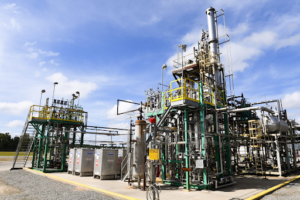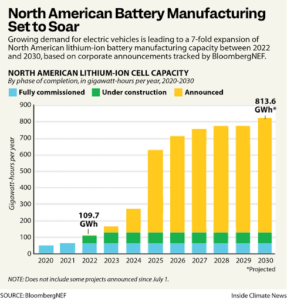This month – Breakthrough Energy’s Catalyst project, the International Energy Agency highlight’s Ukraine’s role in the energy transition, interesting data on EV charging, and more ripples from the Inflation Reduction Act.
Breakthrough Catalyst Increasing the Rate of Progress
 Credit: LanzaJet
Credit: LanzaJet
I was excited to see the Breakthrough Energy Catalyst program recently announce they were providing $50 million in grant funding to LanzaJet, the sustainable aviation fuel (SAF) spinoff of LanzaTech (both are based in the Chicago area). LanzeJet is launching the first commercial-scale alcohol to SAF facility, making jet fuel out of ethanol. The medium-term plan here is to make jet fuel out of advanced biofuels (non-food biomass).
Besides being a positive development for the local ecosystem, this grant is a big deal. It is very forward-looking in that it is helping scale up a process that has the potential to be significantly less emissions-intensive than classic jet fuel, even though the intermediate step is not as dramatic.
Given the energy-density requirements of air travel, this is a hard to decarbonize space. Importantly, proving out practical solutions at scale not only provides another tool to decarbonize, it also makes it easier to move public policy. One reason governments are starting to really accelerate their energy transitions is that the low cost of renewables shows it can be done without messing up an economy in the process.
Do Chargers Dream of Electric Vehicles?
Canary Media highlighted data that electrification research entity Pecan Street collected and published recently about how people charge their electric vehicles (and what impacts behavior).
If you thought the previous sentence sounds interesting you should just go read the whole article, but I would still like to highlight this chart from Pecan Street, which shows that most vehicle charge cycles at 10 kwh or less – and more than 35% are under 5 kwh (for reference, a new Tesla Model Y’s battery is about 80 kwh, so this is a pretty small charge).
 Credit: Pecan Street, via Canary Media
Credit: Pecan Street, via Canary Media
This chart makes a lot of sense when you think about it – with ranges over 200 miles, most people just don’t use that much of their battery any one day, and then they plug it in overnight. Occasionally, for long distance trips, they do, and so you have a tail of 10-15% of charge cycles where they are pulling significantly more electricity.
This data has significant implications for how we need to adjust our regulations and our infrastructure over time. For example, for urban areas planning EV charging, it suggests that a little bit of charging capacity could go a long way in most areas, but that you’ll want high capacity chargers along highways where folks are traveling long distances.
World Energy Outlook
The International Energy Agency is out with their annual World Energy Outlook report. Here’s the executive summary. The report suggests that global fossil fuel use will peak in the near future as a result of the rapid deployment of renewables, and new policies being put in place. Of note:
“It’s notable that many of these new clean energy targets aren’t being put in place solely for climate change reasons,” said Fatih Birol, the agency’s executive director, in an interview. “Increasingly, the big drivers are energy security as well as industrial policy — a lot of countries want to be at the leading edge of the energy industries of the future.”
One observation in the report is that Russia’s invasion of Ukraine is expected to speed up the energy transition, not slow it down – one of several factors contributing to the accelerating transition. As the New York Times notes:
While some nations are burning more coal this year in response to natural-gas shortages spurred by Russia’s invasion of Ukraine, that effect is expected to be short-lived…
…One major reason is that many countries have responded to soaring prices for fossil fuels this year by embracing wind turbines, solar panels, nuclear power plants, hydrogen fuels, electric vehicles and electric heat pumps.
Speaking of Ukraine and Russia, Axios Generate noted that so far at least, Europe has had a significantly warmer autumn than average. So, western European countries have gotten lucky so far as they try to adjust their economies to importing dramatically less natural gas from Russia.
Lots of Excited Noises: The Inflation Reduction Act as a Two-Month Old
As the parent of very young children, it is hard not to see the corollary between infants and the Inflation Reduction Act. It has barely just come into existence, but already things are SO DIFFERENT than they were before, and the future is full of promise – and it doesn’t even really do much of anything yet! Many provisions haven’t kicked in, and some of the ones that have are awaiting guidance from relevant agencies.
But, that hasn’t stopped companies from making announcements. The domestic sourcing requirements for electric vehicles appears to be having the intended effect (Climate law spurs ‘big jumps’ in U.S. battery investments – E&E News, 10/19). As if on queue, GM CEO Mary Barra announced the company would meet all the domestic sourcing requirements for EV tax credits within 3 years.
Inside Climate News covered how a lot of new battery manufacturing facilities are going to be in the Midwest (and this doesn’t even include things announced since the Inflation Reduction Act was passed).

For reference, that amount of battery manufacturing would be enough for 2/3rds of the light duty vehicle market in 2030.
Also, on Twitter, Jesse Jenkins flagged that Credit Suisse thinks the Inflation Reduction Act will mean more than twice as much financial support for climate and energy than the Congressional Budget Office’s estimate, because of the uncapped nature of the tax credits for electric vehicles and zero-carbon electricity (hat tip to Jesse, and also Robinson Meyer at The Atlantic for highlighting this).
As the chart above, and lived experience indicate – they grow up so fast!
Other News
The first Cobalt mine in the United States in 30 years just opened in Idaho. Link
FERC thinks Texas’ grid is still vulnerable to extreme weather. Link
Canary Media article on the potential for electric buses and municipal buildings to be resiliency centers with vehicle-to-building bidirectional capabilities. Link
Toyota is planning to shift its EV strategy. After being the market leader in hybrids with the Prius, Toyota has dropped to an also-ran currently on EVs, misjudging the rate at which EVs are being adopted. Link
Lula da Silva’s election in Brazil is good news for the Amazon Rainforest, one of the world’s largest carbon sinks (in addition to having incredible biodiversity). Link
Climate Draft created a resource hub for tech workers who were recently laid off and are interested in pursuing a career in climate tech. Link